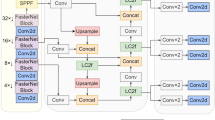Abstract
To achieve real-time segmentation with accurate delineation for feasible areas and target recognition in Unmanned Surface Cleaning Vessel (USCV) image processing, a segmentation approach leveraging visual sensors on USCVs was developed. Initial data collection was executed with remote-controlled cleaning vessels, followed by data cleansing, image deduplication, and manual selection. This led to the creation of WaterSeg dataset, tailored for segmentation tasks in USCV contexts. Upon comparing various deep learning-driven semantic segmentation techniques, a novel, efficient Muti-Cascade Semantic Segmentation Network (MCSSNet) emerged. Comprehensive tests demonstrated that, relative to the state of the art, MCSSNet achieved an average accuracy of 90.64%, a segmentation speed of 44.55fps, and a 45% reduction in model parameters.













Similar content being viewed by others
References
Wei, L., Tianwei, L., Shangyue, Z., et al.: Technology development and prospect of unmanned surface vessels. Ship Electr. Eng. 41(04), 1–3 (2021)
Ling, C.H.E.N.: Analysis of the application of unmanned technology in the surface garbage cleaning ship. Marine Equip. Mater. Mark. 01, 50–51 (2020)
Long J, Shelhamer E, Darrell T. (2015) Fully convolutional networks for semantic segmentation. In: proceedings of the IEEE conference on computer vision and patternrecognition. Santiago: IEEE, 3431–3440
Badrinarayanan, V., Kendall, A., Cipolla, R.: Segnet:a deep convolutional encoder-decoder architecture for image segmentation. IEEE Trans. Pattern Anal. Mach. Intell. 39(12), 2481–2495 (2017)
Ronneberger O, Fischer P, Brox T (2015) U-net:convolutional networks for biomedical image segmentation. In: international conference on medical image computing and computer-assisted intervention. Springer, Cham, 234–241
Zhao H, Shi J, Qi X et al (2017) Pyramid scene parsing network. In: Proceedings of the IEEE conference on computer vision and pattern recognition. Honolulu: IEEE, 2881–2890
Chen LC, Papandreou G, Kokkinos I et al. Semantic image segmentation with deep convolutional nets and fully connected CRFs [EB/OL]. [2014-12-22]. https://arxiv.org/abs/1412.7062
Chen, L.C., Papandreou, G., Kokkinos, I., et al.: Deeplab: semantic image segmentation with deep convolutional nets, atrous convolution, and fully connected CRFs. IEEE Trans. Pattern Anal. Mach. Intell. 40(4), 834–848 (2017)
Chen LC, Papandreou G, Schroff F et al. Rethinking atrous convolution for semantic image segmentation [EB/OL]. [2017-06-17]. https://arxiv.org/abs/1706.05587
Chen LC, Zhu YK, Papandreou G et al (2018) Encoder-decoder with atrous separable convolution for semantic image segmentation. In: proceedings of the european conference on computer vision(ECCV). 801–818
Fu J, Liu J, Tian H, Li Y, Bao Y, Fang Z, Lu H (2019) Dual attention network for scene segmentation. In: IEEE conference on computer vision and pattern recognition (CVPR)
Gui, L.I.N.G., Yanjun, L.I., Junwei, Z.H.O.U., et al.: Water area segmentation model design and channel pruning acceleration method for unmanned ship. Ind. Control Comput. 35(05), 73–75 (2022)
Tang Wei, Liu Si-yang, Chen Jing-xia et al (2018) Water Surface Target Segmentation and Recognition Method Based on Computer Chinese Society of Automation. In: 2018 China Automation Conference (CAC2018) Proceedings. [Publisher unknown], 6
Rui, X., Liang, C., Tao, H., et al.: Research on fast segmentation algorithm of feasible region and obstacles of unmanned surface vessels. J. Electr. Meas. Instrum. 37(02), 11–20 (2023). https://doi.org/10.13382/j.jemi.B2205804
Yulong, Q., Xuechen, Z.: Obstacle detection method based on improved semantic segmentation model. J. Naval Univ. Eng. 35(01), 18–24 (2023)
Cheng Y, Zhu J, Jiang M et al. FloW: a dataset and benchmark for floating waste detection in inland waters [C]. 2021 IEEE/CVF International Conference on Computer Vision (ICCV) (2021)
Krizhevsky, A., Sutskever, I., Hinton, G.E.: Image Net classification with deep convolutional neural networks. ACM 60, 84–90 (2017)
Liu S, Huang D (2018) Receptive field block net for accurate and fast object detection. In: proceedings of the european conference on computer vision (ECCV), 385–400
Hou Q, Zhou D, Feng J (2021) Coordinate attention for efficient mobile network design. In: Proceedings of the IEEE/CVF conference on computer vision and pattern recognition. 13713–13722
Woo S, Park J, Lee JY, et al. (2018) CBAM: convolutional block attention module. In: Proceedings of the european conference on computer vision (ECCV), 3–19
Selvaraju, R.R., Cogswell, M., Das, A., et al.: Grad-CAM: visual explanations from deep networks via gradient-based localization. Int. J. Comput. Vis. 128, 336–359 (2020)
Kisantal M, Wojna Z, Murawski J, et al. (2019) Augmentation for small object detection. In: 9th international conference on advances in computing and information technology (ACITY 2019)
Author information
Authors and Affiliations
Contributions
1.Shen:Method innovation, paper writing, program writing; 2.Zhang:Paper review 3.Liu feiyue:draw pictures 4.Liu chun:make a table
Corresponding author
Ethics declarations
Conflict of interest
The authors declare no conflict of interest.
Additional information
Publisher's Note
Springer Nature remains neutral with regard to jurisdictional claims in published maps and institutional affiliations.
Rights and permissions
Springer Nature or its licensor (e.g. a society or other partner) holds exclusive rights to this article under a publishing agreement with the author(s) or other rightsholder(s); author self-archiving of the accepted manuscript version of this article is solely governed by the terms of such publishing agreement and applicable law.
About this article
Cite this article
Shen, J., Zhang, Y., Liu, F. et al. Lightweight segmentation algorithm of feasible area and targets of unmanned surface cleaning vessels. Machine Vision and Applications 35, 63 (2024). https://doi.org/10.1007/s00138-024-01537-z
Received:
Revised:
Accepted:
Published:
DOI: https://doi.org/10.1007/s00138-024-01537-z




